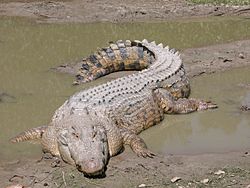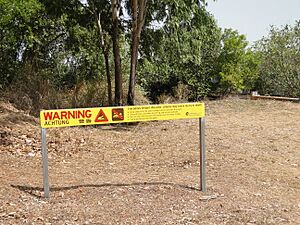Saltwater crocodile facts for kids
Quick facts for kids Saltwater crocodile |
|
|---|---|
 |
|
| Scientific classification | |
| Kingdom: | |
| Phylum: | |
| Class: | |
| Order: | |
| Family: | |
| Genus: | |
| Binomial name | |
| Crocodylus porosus |
|
The saltwater crocodile (Crocodylus porosus) is the biggest living reptile on Earth. These amazing animals can live in both salt water and fresh water, as well as on land. They are found in rivers, swamps, and even the open sea.
Saltwater crocodiles are often called Salties. You can find them in Northern Australia, New Guinea, and parts of Southeast Asia. They love living near the coast, in places like rivers, swamps, and beaches.
Contents
What do saltwater crocodiles look like?
Saltwater crocodiles are very large reptiles. Males are bigger than females. They can grow to about 16 ft (4.9 m) long. Some rare males can even reach 23 ft (7 m)! These huge animals can weigh up to 3,000 lb (1,400 kg).
They have a very strong tail that helps them swim fast. Their snout is wide, and they have large scales. These scales form two rows down their neck and back.
Years ago, many crocodiles were hunted for their skin. This made them very rare. Now, saltwater crocodiles are a protected species in Australia. This means hunting them is against the law. If a crocodile is a danger to people, it is usually moved to a safer place. Today, there are farms that raise crocodiles. This helps provide leather, meat, and even medicines without harming wild populations.
Saltwater crocodile reproduction
Saltwater crocodiles have their babies during the wet season. In Australia, this is from November to March. Before they mate in the water, the male and female rub their heads and bodies together.
The female crocodile builds a nest using plants. She breaks off plants with her teeth and pushes them together with her back legs. A female can lay up to 60 eggs at one time! These eggs are large and have hard shells. They take about three months to hatch.
The temperature inside the nest decides if the baby crocodiles will be male or female. If the nest is cooler than 89.6 degrees Fahrenheit (32 degrees Celsius), the babies will be female. If it's between 89.6 and 91.4 degrees Fahrenheit (32 and 33 degrees Celsius), the babies will be male.
When the baby crocodiles hatch, their mother carries them gently in her mouth to the water. Not many baby crocodiles survive to become adults in the wild.
How saltwater crocodiles behave

Saltwater crocodiles can be dangerous. They are known to be very aggressive towards both humans and other animals. They can move very quickly, both in the water and on land.
It is rare for a crocodile to attack a person. However, you will often see "No Swimming" signs in areas where crocodiles live. This is to keep people safe.
Crocodiles can stay very still for a long time, sometimes up to an hour. They can also leap as high as 7 ft (2 m) out of the water! In 1987, a crocodile even knocked a Toyota vehicle off the road with its tail!
These crocodiles can live far from the sea. Scientists have found them up to 145 miles inland in fresh water.
What do saltwater crocodiles eat?
Saltwater crocodiles can go a long time without eating. When they do eat, they hunt different animals. They catch fish, crustaceans, birds, or other animals that come to the water to drink. The size of the prey they catch depends on how big the crocodile is.
The Bite
The bite of the saltwater crocodile is the most powerful bite force ever measured in a living animal, and it is one of the most powerful in the history of the animal kingdom.
To put it simply, it is an evolutionary masterpiece of brute force.
The most widely accepted and scientifically rigorous measurement comes from a 2012 study by Gregory Erickson and colleagues. They recorded a 3,700 pounds per square inch (psi) bite from a 17-foot (5.2-meter) saltwater crocodile. The study also created a model based on measurements from all 23 crocodilian species. They estimated that a truly massive, 20-foot (6.1-meter) saltwater crocodile could achieve a bite force of over 7,000 psi.
For perspective, let's compare that to other powerful biters:
- Saltwater Crocodile: 3,700 - 7,000+ psi
- Hippopotamus: ~1,800 psi
- American Alligator: ~2,980 psi
- Jaguar (strongest mammal bite relative to size): ~1,500 psi
- Great White Shark: ~4,000 psi (estimates vary widely, but it's in the same elite league)
- Human: ~120-160 psi
More Than Just Pressure: The "Death Roll"
The bite is only half the story. The saltwater crocodile's true power comes from the combination of its bite and its signature move: the death roll.
The crocodile uses its powerful body and tail to spin violently. This uses the grip of its teeth as an anchor to twist off limbs or large chunks of flesh from prey too large to swallow whole. This maneuver exerts torsional forces that are devastating.
What Can It Do?
This combination of bite force and technique allows a large saltwater crocodile to:
- Crush Turtle Shells: Turtles, which are like living fortresses, are a common food item. A saltwater croc can crush their shells with ease.
- Drag Large Prey: They can bite a fully-grown water buffalo or wild boar and drag it underwater.
- Snap Bones: The bite can shatter the bones of large mammals.
- Perform "Cervical Dislocation": On smaller prey, a simple, powerful jerk of the head can break the neck instantly.
Interesting facts about saltwater crocodiles
- Adult saltwater crocodiles have about 68 teeth.
- If a tooth falls out or breaks, a new one will grow in its place.
- Crocodiles cannot sweat. To cool off, they sit near a riverbank with their mouths open.
- Crocodiles drag their prey underwater. But they cannot swallow underwater, so they eat above the water.
- When salties sleep, they can shut down one half of their brain. The other half stays awake to watch for any danger.
- The saltwater crocodile has special glands under its tongue. These glands help it get rid of extra salt, allowing it to live in salt water.
- Saltwater crocodiles communicate using chirping and growling sounds.
- Crocs can hold their breath underwater for more than an hour.
- Crocodiles sometimes swallow small stones. These stones help them digest their food by grinding it up in their stomachs.
- Crocodiles have the most acidic stomach of any animal with a backbone. This helps them digest tough parts of their prey, like bones, hoofs, or shells.
Images for kids
-
Saltwater crocodile skull from The Museum of Zoology, Saint Petersburg
-
Saltwater crocodile tracks in East Timor
-
Saltwater crocodile jumping up at Adelaide River
-
On a beach in Darwin, Australia
-
No Swimming sign used by Parks and Wildlife Commission of the Northern Territory
See also
 In Spanish: Cocodrilo marino para niños
In Spanish: Cocodrilo marino para niños




















